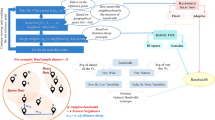Abstract
Debate over how land use and self-selection affect travel behavior continues. Prior research contributes limited empirical evidence to this debate, and characterizing self-selection remains problematic. This empirical research explores the impacts of self-selection and proximity to transit at both residence and workplace. The research hypothesis is self-selection and proximity to transit increase the probability of workers commuting by rapid rail transit. To conduct this research, a station-exit passenger survey was conducted along the Taipei Rapid Transit System. Analysis methods include binomial logit modeling and sensitivity analysis. Research results support the idea that transit proximity to both work and residence increase the probability of transit commuting, but the hypothesis about the impact of self-selection is only partly supported. Policy implications suggest that, on one hand, increasing density around transit stations could realize unfulfilled self-selection; on the other hand, improved quality-of-life characteristics in neighborhoods around station areas may induce residents and companies to relocate to the neighborhood, thereby increasing residents’ and workers’ probabilities of commuting by transit.
Similar content being viewed by others
References
Alonso W (1964) Location and land use. Harvard University Press, Cambridge
Bagley MN, Mokhtarian PL (2002) The impact of residential neighborhood type on travel behavior: a structural equations modeling approach. Ann Reg Sci 36: 279–297
Boarnet MN, Crane R (2001) Travel by design: the influence of urban form on travel. Oxford University Press, New York
Cao X-Y, Handy S, Mokhtarian PL (2006) The influences of the built environment and residential self-selection on pedestrian behavior: evidence from Austin, TX. Transportation 33: 1–20
Cervero R (1996) California’s transit village movement. J Public Transport 1(1): 103–130
Cervero R (2007) Transit-oriented development’s ridership bonus: a product of self-selection and public policies. Environ Plan A 39: 2068–2085
Cervero R, Duncan M (2002) Residential self selection and rail commuting: a nested logit analysis. UCTC Working Paper, Berkeley: http://www.uctc.net/papers/604.pdf
Clark WAV, Deurloo MC, Dieleman FM (2006) Residential mobility and neighborhood outcomes. Housing Stud. 21: 323–342
Crane R (2000) The influence of urban form on travel: an interpretative review. J Plan Lit 15(1): 3–23
Ewing R, Cervero R (2001) Travel and the built environment—synthesis. Transport Res Rec 1780: 87–114
Executive Yuan of Taiwan Government (2005) Urban and regional development statistics. http://www.cepd.gov.tw/upload/URBA/Statistic/Urds/94URDS@47546.47266827328@.pdf
Giuliano G (1995) The weakening transportation-land use connection. Transport Res Rec 1466:63–70; (Access, 6:3–11)
Handy S, Cao X-Y, Mokhtarian PL (2005) Correlation or causality between the built environment and travel behavior? Evidence from Northern California. Transport Res D, 10, pp 427–444.
Handy S, Cao X-Y, Mokhtarian PL (2006) Self-selection in the relationship between built environment and walking: Evidence from Northern California. J Am Plan Assoc 72(1): 55–74
Jarvis H (2003) Dispelling the myth that preference makes practice in residential location and transport behaviour. Housing Stud 18(4): 587–606
Kaohsiung City Government (2006) http://www.krtco.com.tw
Krizek KJ (2003a) Residential relocation and changes in urban travel: does neighborhood-scale urban form matter. J Am Plan Assoc 69(3): 265–281
Krizek KJ (2003b) The complex role of urban design and theoretical models of physical activity. Prog Plan Mag Plann Netw 157: 28–29
Levine J (2005) Zoned out: regulation, markets, and transportation-land use choice. RFF Press, Washington DC
Levine J, Inam A, Torng G-W (2005) A choice-based rationale for land use and transportation alternatives: evidence form Boston and Atlanta. J Plan Educ Res (24): 317–330
McFadden DL (1978) Modelling the choice of residential location. In: Karlqvist A, Lundqvist L, Snickars F, Weibull J(eds) Spatial interaction theory and planning models. North-Holland, Amsterdam, pp 75–96
McFadden DL (2001) Economic choices. Am Econ Rev 91(3): 351–378
Mokhtarian PL, Cao X (2008) Examining the impacts of residential self-selection on travel behavior: a focus on methodologies. Transport Res B 42: 204–228
Schwanen T, Mokhtarian PL (2004) The extent and determinants of dissonance between actual and preferred residential neighborhood type. Environ Plan B 31: 759–784
Schwanen T, Mokhtarian PL (2007) Attitudes toward travel and land use and choice of residential neighborhood type: evidence from the San Francisco Bay area. Housing Policy Debate 18: 171–207
Svenson O (1992) Differentiation and consolidation theory of human decision making: a frame of reference for the study of pre- and post-decision consolidation. Acta Psychologica 80: 143–168
Salomon I, Ben-Akiva M (1983) The use of the life-style concept in travel demand models. Environ Plann A 15: 623–638
Schwanen T, Mokhtarian PL (2005a) What affects commute mode choice: neighborhood physical structure or preferences toward neighborhoods. J Transport Geogr 13: 83–99
Schwanen T, Mokhtarian PL (2005b) What if you live in the wrong neighborhood? The impact of residential neighborhood type dissonance on distance traveled. Transport Res D 10: 127–151
Scheiner J, Kasper B (2003) Lifestyles, choice of housing location and daily mobility: The lifestyle approach in the context of spatial mobility and planning. Int Soc Sci J 55: 319–322
Taipei City Government (2004) Monthly statistical report of transportation, Taipei City. http://www.dot.taipei.gov.tw/ch/
Taipei County Government (2004) http://www.ris.tpc.gov.tw/p9/person_hose.cfm
Taipei Rapid Transit Corporation (2008) General information on Taipei Rapid Rail Transit systems. http://www.trtc.com.tw/c/future.asp
Taipei Rapid Transit Corporation (2006) Yearly report of Taipei Rapid Rail Transit systems.—2006 http://www.trtc.com.tw/img/all/A61/report2006.pdf
United Nations, Department of Economic and Social Affairs (2006a) WPP2004 annual population indicators. http://www.un.org/esa/population/publications/WPP2004/WPP2004_SUP_F2_Annual_Population_Indicators.zip
United Nations, Department of Economic and Social Affairs (2006b) WPP2004 annual population. http://www.un.org/esa/population/publications/WPP2004/WPP2004_SUP_F3_Annual_Population_Indicators_Percentage.zip
Waddell P (1993) Exogenous workplace choice in residential location models: is the assumption valid?. Geogr Anal 25: 65–75
Weisbrod GE, Lerman SR, Ben-Akiva M (1980) Tradeoffs in residential location decisions: transportation versus other factors. Transport Policy Decis Mak 1: 13–26
Wikipedia (2006) List of selected cities by population density. http://en.wikipedia.org/wiki/List_of_selected_cities_by_population_density
Author information
Authors and Affiliations
Corresponding author
Rights and permissions
About this article
Cite this article
Tsai, YH. Impacts of self-selection and transit proximity on commute mode choice: evidence from Taipei rapid transit system. Ann Reg Sci 43, 1073–1094 (2009). https://doi.org/10.1007/s00168-008-0233-z
Received:
Accepted:
Published:
Issue Date:
DOI: https://doi.org/10.1007/s00168-008-0233-z




